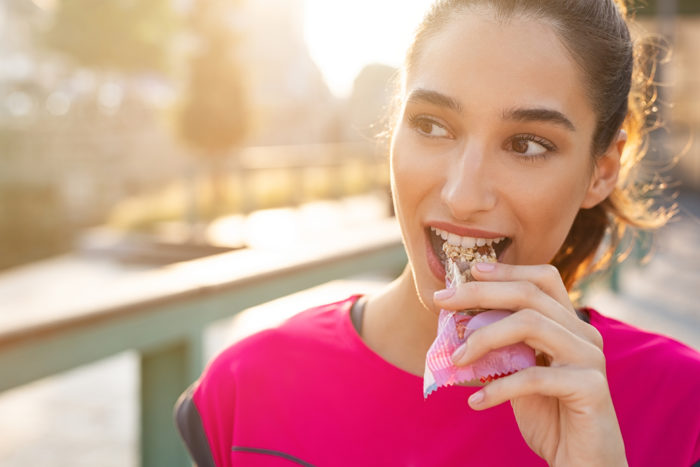Did you know that a real food diet can be an effective method for losing weight safely? Keep reading to learn my five best tips for weight loss while eating real foods.
Reaching a weight loss goal may not be the primary reason why many people switch to a real food diet.
But if you’ve been struggling to lose weight, or actually keep the weight off, switching to a real-food diet could be the missing piece.
Over the years the benefits of adopting a “real food” approach to eating has shown to improve glucose tolerance in people with high blood sugar, improve metabolic markers associated with heart disease, and help people lose weight.
The basic premise of a real food diet is that you eat only whole, unprocessed foods, like the ones our ancestors would have had access to.
There is no calorie counting, macro cutting, or cycles of binging and restricting. Simply getting rid of processed, inflammatory foods, and focusing on primarily vegetables, fruits, meats, and healthy fats is enough to make losing weight possible with this diet.
But don’t get me wrong, a real food diet isn’t a magic bullet for weight loss. The concept of calories in versus calories out still applies. Plus, there are so many other, non-diet related, factors that come into play when trying to lose weight.
As I’ve counseled clients with weight loss goals in using a real food or whole food diet, I’ve come up with a few tips that seem to help make their efforts even more successful.
So, if you’re trying to use a real food diet to lose weight, keep reading, this one’s for you!

Tip #1 for Losing Weight on a Real Food Diet: Don’t Accidentally Undereat
When you first make the switch to a real-food diet, you often lose a lot of calories.
If you think about some of the common whole food swaps, you’ll see that the caloric intake of those real-food alternatives are sorely lacking.
For example, if you swap out ½ cup of regular pasta for ½ cup of zucchini noodles you’re losing about 150 calories in that transition.
And while a caloric deficit is necessary to lose weight, if you cut your calories too much, your body starts to take notice and conserve its energy.
Diets too low in calories can decrease the total number of calories your body burns by as much as 23%. In other words, if you eat less, you’ll also burn less.
Long-term caloric deficits can also reduce thyroid hormone production and raise stress hormone levels. Both of which are huge contributing factors in weight loss resistance.
And if you’re making a few of those real food swaps each day, that calorie deficit can start to get pretty large.
Change Your Mindset to Eat Enough
You can use this calculator to determine your baseline caloric needs based on your current level of activity. From there, I recommend about 200-300 calories from that number for slow, sustainable weight loss.
And even though you are typically cutting out processed grains, and refined sugars on a real food diet, this style of eating isn’t inherently low in calories.
If you do find that undereating is stalling your weight loss progress, make sure that you’re including plenty of real-food carbs and healthy fats in your meals.
Some of my favorite real food carbs include sweet potatoes, plantains, taro root, yucca, bananas, and berries.
And good sources of healthy fats include coconut products, ghee, lard, and avocados.
If you’re still struggling with undereating and not being able to lose weight on a real food diet, I recommend checking out my eBook, Overcoming Undereating.
In it, I walk you through the common signs of undereating on a real food diet and how to overcome this hurdle to get back to full health.

Tip #2 for Losing Weight on a Real Food Diet: Skip the “Healthy” Baked Goods
Just because a food or recipe is touted as “Paleo” or “real food” doesn’t mean that it’s 100% healthy.
While Paleo foods, even Paleo baked goods, are definitely healthier than their Standard American counterparts, they’re still not necessarily going to promote weight loss.
As much as I love a good Paleo recipe or real-food-focused baked good, I’ve got to admit – many of the recipes you see on popular recipe websites are not ideal for those who are trying to lose weight.
These foods are “Paleo,” and “real” and they sure are delicious, but therein lies the problem. Even real food can be high in both sugar and fat, making them highly rewarding, drive overconsumption (i.e. past the point of satiety), and actually spur on fat gain simply because of how darn tasty they are. Bummer, right?
I’m not saying you have to give up desserts entirely or eat unsalted chicken breasts and dry broccoli every night in order to lose weight. (Gross.)
Indulging occasionally in some sweet ‘healthified” treats isn’t going to totally derail your weight loss efforts.
Just remember, desserts are still desserts, even if they’re grain-free or made without refined sugar.
If you are having trouble losing weight on a real food diet, take a hard look at what you’re eating.
You don’t have to completely abstain from treats while pursuing a weight loss goal. But, making them an occasional indulgence rather than a daily occurance can go a long way in helping to drop those last few pounds.
Would you like to save this post?
Your email address is 100% safe and will never be sent spam.

Tip #3 for Losing Weight on a Real Food Diet: Lift Heavy Weights
Another common fallacy in the world of weight loss is that cardio is the only exercise you need, and that heavy weight lifting will only bulk you up. (I’m talking to you here, ladies!)
True, you may not lose quite as many pounds if you’re lifting heavy weights on a regular basis; after all, muscle weighs more than fat (i.e. denser) while taking up less space. But when it comes to health and making fat loss sustainable, a little added muscle can go a long way.
Adding muscle can also significantly increase your ability to use glucose (aka blood sugar) in a healthy way. Population studies show that greater muscle mass strongly correlates with improved insulin sensitivity, and the less glucose you have floating around in your blood going unused by cells, the more of it that gets stored as fat.
In fact, weight lifting and other types of high-intensity muscle use have been shown to increase glucose utilization without the need for insulin, helping to lower blood sugar even further.
Cardio Isn’t All Bad Either
I’m not knocking cardio here: in fact, a combination of cardio and weight training has been shown to be one of the best exercise strategies for weight loss.
And high-intensity interval training has many benefits, including a reduction in blood sugar for hours after exercising. But rather than plugging away on the elliptical machine for 45 minutes every day, mix it up with some heavy resistance training 2-3 days per week. You’ll get more bang for your exercise buck, and get some metabolic benefits to boot.
Plus, if you’re eating a real food or Paleo diet, all those all-star nutrients will help you build muscle mass and lose weight even faster than if you were eating a Standard American diet.
So, if lifting weights hasn’t done anything for you in the past, your new diet could be the missing piece to truly reaping the benefits of this practice.
No matter what you do to exercise, though, make sure it’s something you enjoy. You’re more likely to stick to an exercise program that brings you happiness compared to one that makes you dread going to the gym.

Tip #4 for Losing Weight on a Real Food Diet: Don’t Ignore Stress
Stress is one of the linchpins of the majority of my clients’ health and weight loss success.
If they’re able to get stress under control, they find it far easier to meet their health goals compared to those clients who can’t find a way to manage their daily stressors.
For better or worse, stress is a part of all of our lives, and keeping it to a minimum should be a key strategy of any smart weight loss program.
Managing stress may seem to be outside the bounds of the Paleo diet. But, in reality, if you’re trying to live like our ancestors did, their stress levels were WAY lower than ours are today.
If eating more vegetables and grass-fed meat isn’t helping you to reach your weight loss goals, that’s okay. Digging deeper into your stress management abilities is the next step to help you get to where you want to be.
The Autoimmune Paleo approach does a great job of incorporating stress management techniques and practices into its teachings. So, if you’re struggling with ways to manage your stress, and want to go at it from an ancestral approach, AIP has some great resources.
Find an Approach that Works for You
There are many ways to manage stress, so you should pick one that works for you. I personally love journaling (especially prayer journaling) and try to do it once a day to help me manage my own anxiety that creeps up when life gets hectic. Some people like meditation or yoga, others enjoy going for nature walks, and some prefer to splurge on massages or other pampering experiences.
Find something that you love and that works to get your stress levels down… and then do it on a regular basis. Weekly, daily, twice daily – however often you feel is necessary to keep your mental state calm and happy!
This goes for getting enough sleep too. Inadequate or poor quality sleep is a huge stressor on the body, and a good night’s sleep can do wonders for your energy, mood, and stress levels.
There are some awesome herbal remedies that can help you sleep better, and your diet plays an important role as well. I’m experimenting with lavender oil right now, and I’m finding it’s great for keeping me calm and helping me fall asleep more quickly! (Just have to be okay with having “potpourri burps” now and then!)

Tip #5 for Losing Weight on a Real Food Diet: Get Help From a Professional
Losing weight and keeping it off is hard. I don’t think there’s a single person out there who would tell you weight loss is easy and keep a straight face.
Sure, there are plenty of “get skinny quick” protocols out there that promise immediate results. But those plans typically don’t help their users get sustainable, healthy, long-lasting results in their weight loss endeavors.
In fact, many of these “lose weight fast” gimmicks leave dieters on a weight loss-weight gain rollercoaster that can really mess with their metabolism.
Sustainable weight loss takes time and dedication. And it’s a lot easier to lose weight when you’re getting help from someone who’s spent years studying the topic of nutrition and healthy weight loss.
It also helps to work with someone who doesn’t think you need to get “shredded” or “stick thin” to be a weight loss success story.
Personally, I want my clients to be healthy and happy, above anything else. I understand that losing weight can contribute to happiness through increased confidence, energy, and overall contentment with life. That’s why a diet shouldn’t be something that makes you miserable, sick, fatigued, or fed up.
And if you’re using a real food diet to lose weight, you’ve already got a great baseline for sustainable, healthy weight loss.
But there are so many other factors that play into your weight loss success. Working with a qualified registered dietitian or licensed nutritionist can help you identify those other factors and make the appropriate changes so you can lose weight in the safest and least stressful way possible.
Which one of these tips are you going to incorporate into your real food approach to weight loss? Share your story with me in the comments below!
This post may contain affiliate links. If you click on a link and make a purchase, I may receive a small commission.

+ show Comments
- Hide Comments
add a comment